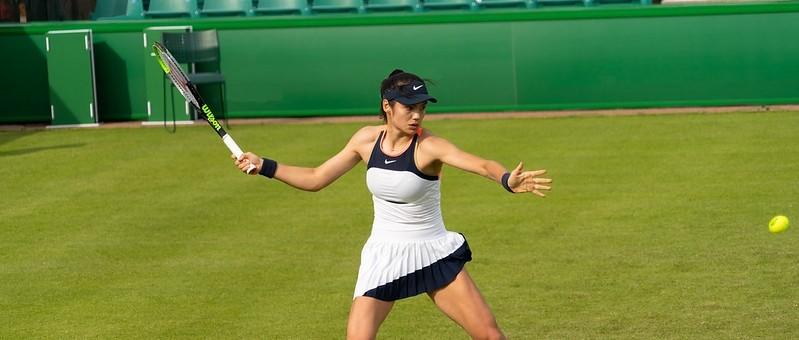
Women's health in sport: injuries, menstruation, and motherhood
Peer reviewed by Dr Krishna Vakharia, MRCGPAuthored by Amberley DavisOriginally published 9 Jan 2024
Meets Patient’s editorial guidelines
- DownloadDownload
- Share
- Language
- Discussion
From the superstardom of the England Lionesses and BBC Sports Personality of the Year 2023 Mary Earps, to young trailblazers like tennis star Emma Raducanu and snowboarder Mia Brookes, there's a real buzz around women's sport.
Still, gender inequalities in sport persist at all levels, including health care. Should factors unique to women - like physical build, periods, pregnancy, and recovery after giving birth - inform sports health advice?
In this article:
Continue reading below
What health challenges do women face?
You might be one of the growing number of girls and women inspired by increasingly visible role models, record-breaking broadcast audiences, and more encouragement from your schoolteachers, parents, and peers to pursue sports - compared to previous decades.
But is sports medicine research keeping up with you? According to experts, we need more research on how sex differences affect sporting performance and injury rates. Training, nutrition, and recovery advice are still very much tailored to the male body.
A study of women in Sport and Exercise Medicine (SEM):
According to this 2023 research, women are1:
Under-represented in research for sports and exercise.
Under-represented in sports medicine leadership roles - accounting for less than 20% of US sports team doctors2.
Often absent from conference panels and are rarely keynote speakers in SEM.
This under-representation is having a knock-on effect for women's health in sport.
Medical knowledge gaps - in areas such as nutrition and exercise training for the female body, as well as post-pregnancy (postpartum) physiology research to support healthy female athletes.
Workplace challenges - female sport doctors have their judgement questioned more often than their male counterparts3.
Reduced sport participation - playing sports promotes an active lifestyle that supports health throughout our lives, yet many teenage girls are dropping out of sports.
With the help of a sports and exercise medicine consultant, a sports dietitian who loves running, and a physiotherapist with personal track and field experience, we shine a spotlight on some of the biggest challenges faced by females who enjoy sports at all levels, whether in the playground, outside of work, or as a full-time career.
Higher rates of injuries
If you've endured a sports injury, you're in good company. Sports injuries are probably the most measurable challenge faced by women. Across many different sports, the risk of anterior cruciate ligament (ACL) injury - the ligament connecting your thigh bone to your shinbone - is 3 to 8 times greater in women than in men4.
According to Dr Natasha Beach, sports and exercise medicine consultant, there's an anatomical reason for this: "a woman's pelvis is typically wider than a man's, meaning that the force through the knee is different. Women also tend to have less muscle bulk and more flexible ligaments which results in less internal strength to counteract an outside blow to the leg."
It's not just ACL differences between the female and male body that might be putting you at a disadvantage, as physiotherapist, and track and field athlete Nelly Darbois knows through professional and personal experience.
"When I was a teenager, I experienced many injuries as a heptathlete, including quadriceps and calf tears, recurring shin splints, and a lumbar strain that developed into chronic lower back pain."
Continue reading below
Is sex-specific training advice the answer?
Darbois continues: "At that time, both boys and girls had the same training load. Of course, we adjusted the intensity of our efforts based on our individual capacities, but the frequency and duration of training and other tips were the same for everyone.
"As a physiotherapist, I know that we are not trained to tailor training loads or strength programs based on the genetic differences between women and men. This aspect is not emphasised in our initial or continuing education."
However, there are mixed views on whether sex-specific exercise training advice is the answer here - or whether it's too simple an explanation. "For some, it could be seen as sexist,"
adds Darbois. "It's worth noting that there is often greater variability among people of the same gender than between genders across many parameters."
Still, while training recommendations should be personalised to you as much as possible, many experts say that sex-specific advice can also be useful in optimising women's health and safety. "This is probably possible by taking more precautions as a physiotherapist or coach, for example," agrees Darbois.
But the female body is different to the male body not just because of biomechanics - different hormonal patterns take place, and for many women the physical and mental experience of motherhood also has a big effect.
Sport and the menstrual cycle
You might find that the different phases of your menstrual cycle make a difference. Studies show that many female athletes find their period pain increases during competition time5, and ACL injury rates appear to be more likely during their menstrual ovulation phase6. This evidence appears to link a women's menstrual cycle phases to performance, injury, and general wellbeing in sport.
The menstrual cycle with its monthly sex hormone fluctuations is one of the most fundamental differences between male and female bodies. Dr Beach says: "There's almost certainly a link between risk of injury and menstrual cycle phases. This is currently being researched, the theory being that changes in your hormone levels affect how flexible ligaments are throughout the month."
Yet, this theory remains under-researched, and there is no agreement in the scientific community that sex hormones play an important role in women's health and sport. With more research, it may be possible to establish strong evidence for injury rates, and possibly other effects of menstruation that are more nuanced and harder to measure.
"It's likely that the mental effects of menstruation affect sport performance for some women, but again this is under-researched," says Dr Beach. "There's also the psychological concern of having your period while wearing certain clothing - no matter whether it's a school sports club or the Wimbledon Championships - or just the feeling of being bloated and in pain may affect your ability to perform at your best."
Action on period anxiety
At The Championships, Wimbledon 2023 tennis tournament, organisers relaxed their all-white dress code to help ease period leakage anxiety for female players.
This came after players raised concerns and protestors showed up at the women's finals the previous year demanding a change.
The subtle but landmark change opened a dialogue on the worry surrounding period leakage. British tennis player Heather Watson has since spoken openly about the lengths she has previously gone to, including taking hormonal contraception.
Continue reading below
Pregnancy, motherhood, and returning to sport
There are unique challenges for the women who have children and transition in and out of their sport. If you undergo the physical stresses of pregnancy and childbirth, you need time to rehabilitate fully before returning to high impact exercise.
The traditional concept of full recovery is marked by the 6-week post-birth health check, yet it can take much longer to heal and return to full strength, posing a threat to your health. For example:
Pelvic floor problems: your pelvic floor - the muscles and tissues that support your pelvic organs - stretch and loosen during pregnancy, which can cause problems like urine leakage, constipation, and pain in your lower back or genitals. We know that typical recovery time for these tissues is 4 - 6 months8. If you have had a caesarean birth, this can take up to 7 months. Returning to high impact sport too soon can prevent healing.
Stress fractures: weaker muscles and less bone mineral density (BMD) due to pregnancy and breastfeeding means your muscles are less able to absorb shocks caused by sports activity, and this stress can cause small cracks in the bone. If you return to sport early in the six-week postpartum period, you may have a higher risk of injury, but evidence is very low quality, and more data is needed9.
Relative Energy Deficiency in Sport (RED-S): means you have a lack of energy to the point of risking sport injury and psychological issues. More than feeling tired, RED-S affects your bone health, menstruation, immunity, heart health, and mental health10. Studies show that female athletes who wish to get back to training and their previous fitness and physique after childbirth have a high risk of RED-S, because they may intentionally eat less and exercise more than their bodies can cope with11.
Is sex-specific nutrition the answer?
There are fundamental differences between a women's and a man's body, and your diet can be tailored to cater to these differences.
For example, Dr Beach says that having the right calorie intake and nutrients will not only help sport performance but will also reduce the risk of injuries like stress fractures.
The sports and exercise medicine consultant adds "each person, male or female, will also have their own energy demands - so there isn't a one-size-fits all approach."
Still, studies have shown that hormone fluctuations, energy requirements, and common nutritional deficiencies should be factored into dietary advice for female athletes, and anyone enjoying regular, intense physical activity. One study identified three main considerations12:
The nutrients a female athlete needs may change during different phases of the menstrual cycle - as a result of hormone fluctuations.
Nutrient deficiencies are common in female athletes - particularly vitamin D, iron, and calcium.
Female athletes should aim for energy availability (EA) of 45 kcal·kg-1 fat-free mass·day-1 - a measure of the amount of energy you have left over for your body's essential functions after physical activity.
These factors are unlikely to be as important if you're a casual sports players but you should still aim to consume enough calories and a variety of nutrients to fuel your physical activities.
Sports nutrition, diet culture, and RED-S
Lexi Moriarty is a sports dietitian specialising in RED-S and host of Mind Your Fitness, a podcast about female athletes and harmful body ideals. She is also a runner.
"More sports nutrition research and recommendations specific to the female body, especially related to maintaining normal hormone function during training, could help improve menstrual issues, digestive complaints, and injuries," says the sports dietitian.
But for Moriarty, this research is also important for tackling eating disorders linked to RED-S: “Women playing sports can easily fall victim to the more unhealthy diet culture advice and it can be hard to decipher between researched sports nutrition recommendations and dangerous diet culture advice that feeds into body image concerns.
"Adolescent female athletes are especially vulnerable to disordered eating, body image concerns, eating disorders and RED-S, which can lead to poor nutrition and RED-S related concerns, including a higher risk of injuries.
"Fortunately, there is so much great research coming out regarding RED-S and how important sufficient calories, carbohydrates, and fat intake is for female athletes, and by extension for all active women. These performance nutrition topics are key for both hormone health and injury prevention."
There's still a way to go to get health advice to where it needs be for sportswomen, and to address the underlying gender bias that comes with female under-representation in SEM research.
But positive steps are being made - including FIFA's 2023 launch of its Women's Health, Wellbeing, and Performance project - and many sport health specialists are passionate about translating research into useful guidance that both protects women from harm and enhances their careers.
Dr Beach reminds us that how we apply this research can also be the difference between liberating or inhibiting female sportsplayers: "The main focus should be not to treat all women the same, but to treat each person as an individual."
Further reading
Patient picks for Exercise and physical activity

Healthy living
What is somatic exercise? Exploring the mind-body connection
Introduced in the 1970s by philosopher Thomas Hanna, somatics refers to a discipline that explores the relationship between the mind and body though movement. Somatic exercise is a sensory practice that promotes mindful movements to enhance your awareness of your body’s internal sensations.
by Victoria Raw

Healthy living
Which sports are the worst for your health?
Despite their many health benefits, many sports can lead to injuries if you're not careful. But which sports carry the highest risk of injury and what should you do to stay safe?
by Abi Millar
Continue reading below
Article history
The information on this page is peer reviewed by qualified clinicians.
9 Jan 2024 | Originally published
Authored by:
Amberley DavisPeer reviewed by
Dr Krishna Vakharia, MRCGP

Ask, share, connect.
Browse discussions, ask questions, and share experiences across hundreds of health topics.

Feeling unwell?
Assess your symptoms online for free
Sign up to the Patient newsletter
Your weekly dose of clear, trustworthy health advice - written to help you feel informed, confident and in control.
By subscribing you accept our Privacy Policy. You can unsubscribe at any time. We never sell your data.